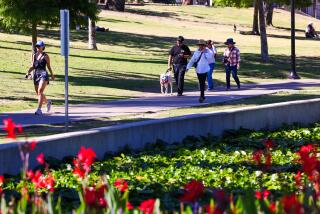Study Suggests Antibiotic Resistance Has Leveled Off
The rate of antibiotic resistance in California appears to have leveled off from 2000 to 2002, and, in some parts of the state, has decreased, according to a new study.
âWe have been working long and hard at this for four years and this ... was, for us, a real confirmation that the approach we chose to take in California is working,â said Elissa Mass, director of the Alliance Working for Antibiotic Resistance Education (AWARE), which helped conduct the study.
But the AWARE study and another released last week show that the state has much more work to do: Nearly half of Los Angeles County residents surveyed reported that they did not take antibiotics as prescribed by their physician.
AWARE is a project of the California Medical Assn. Foundation, which collaborated with the California Department of Health Services on the study.
When patients take antibiotics improperly -- for example, by not finishing a full course of treatment -- bacteria can become resistant, ultimately rendering antibiotics ineffective.
The stateâs health department and the AWARE program compiled data from Kaiser Permanente, Ortho- McNeil Pharmaceutical Inc. and Focus Technologies to assess antibiotic resistance trends in California from 1994 through 2002.
According to the data, the rate of resistance in Northern California fell in the last two years, and apparently leveled off in Southern California. Resistance was measured by examining whether samples of Streptococcus pneumoniae bacteria responded to penicillin.
In Northern California, the rate of antibiotic resistance rose from 17% in 1994 to 27% in 2000, decreasing to 19% in 2002.
In Southern California, however, the proportion increased from 17% in 1994 to 26% in 2000, and inched up to 27% in 2002.
âWeâll be disappointed, but not shocked, if it goes up again, particularly in Southern California,â said Dr. Jon Rosenberg, an epidemiologist with the state Department of Health Services.
Nationally, the rate of resistance hovers between 25% and 30%, depending on the geographic region, Rosenberg said.
It is particularly high in the Southeast, with Kentucky and Florida seeing resistance rates between 30% and 40%, Rosenberg added.
âThis is a long-term public health crisis, but itâs good to see weâre making some progress,â Mass said.
The bad news, however, is that many Los Angeles County residents are at risk for becoming resistant because of their improper use of antibiotics.
In a separate study by the Los Angeles County Department of Health Services, 47% of county residents surveyed said they took antibiotics incorrectly and 28% said they understood the types of illnesses for which antibiotics are effective.
About 75% of all antibiotics prescribed in the United Sates are given for upper respiratory illnesses -- colds, sore throats, bronchitis and sinus and ear infections. Yet at least half of them are unnecessary because the infections are caused by viruses, not bacteria.
âOur study provides valuable evidence about how widespread the misuse of antibiotics really is, and that education needs to be comprehensive with physicians and the public,â Dr. Jonathan Fielding, the countyâs director of public health, said in a prepared statement.
The county survey collected information on a random sample of more than 8,000 adults and nearly 6,000 children with interviews conducted in six languages.
More to Read
Sign up for Essential California
The most important California stories and recommendations in your inbox every morning.
You may occasionally receive promotional content from the Los Angeles Times.










